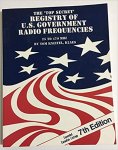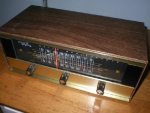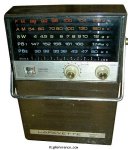You are using an out of date browser. It may not display this or other websites correctly.
You should upgrade or use an alternative browser.
You should upgrade or use an alternative browser.
What has changed since you started in the hobby?
- Thread starter VA3ADP
- Start date
- Status
- Not open for further replies.
mitbr
Active Member
The quality of scanners has gone down over the years!! 
- Joined
- Feb 22, 2007
- Messages
- 6,371
It's changed like night and day and for me it was a lot more fun then.
Started in late 60s with the tunable monitors, you listen to one frequency at a time. Then you had a choice of Crystal scanners scanning 4 things at a time, then eight and more.
Great VHF repeater systems that kick butt over what we have today and a lot of simplex VHF. You could always tell where the highway patrol was by the way they came in LOL.
Then the first programmable radios in the mid-seventies, no more crystals, just program the frequencies in. A freaking miracle.
Our country was much different then and for me life was better before the degeneration of society as a whole. Things may have been tough during the seventies but nothing like it is today. Of course that makes for better scanning today when you're actually able to hear it.
With all the changes in the laws and the new systems mandated the scanners available are keeping up as best as possible. The cost to the taxpayers is obscene but let's not talk politics and corruption.
Loved my frequency listings and my monthly magazines and newsletters. No computers then.
And of course the quality of the radios was far superior than consumer brand scanners today made in third world countries.
I miss how it used to be but then again I miss a lot of things LOL.
Started in late 60s with the tunable monitors, you listen to one frequency at a time. Then you had a choice of Crystal scanners scanning 4 things at a time, then eight and more.
Great VHF repeater systems that kick butt over what we have today and a lot of simplex VHF. You could always tell where the highway patrol was by the way they came in LOL.
Then the first programmable radios in the mid-seventies, no more crystals, just program the frequencies in. A freaking miracle.
Our country was much different then and for me life was better before the degeneration of society as a whole. Things may have been tough during the seventies but nothing like it is today. Of course that makes for better scanning today when you're actually able to hear it.
With all the changes in the laws and the new systems mandated the scanners available are keeping up as best as possible. The cost to the taxpayers is obscene but let's not talk politics and corruption.
Loved my frequency listings and my monthly magazines and newsletters. No computers then.
And of course the quality of the radios was far superior than consumer brand scanners today made in third world countries.
I miss how it used to be but then again I miss a lot of things LOL.
Last edited:
and the nightly blowing of the vol. fire dept. siren. 2130 in our town.I miss the evening fire tone tests.
Ours was at noon "The Noon Whistle"and the nightly blowing of the vol. fire dept. siren. 2130 in our town.
- Joined
- Feb 22, 2007
- Messages
- 6,371
That is certainly still done but certainly not at 2130, it's more like noon LOL.and the nightly blowing of the vol. fire dept. siren. 2130 in our town.
A lot has changed since I started in the hobby, but I recently spoke on my podcast what has changed in the last decade of scanning and where I think the next 10 years will go.
If you want to take a listen, here is a link: Predictions for the Next Decade in Scanning
Somethings I noted that changed in the last 10 years were:
- Database style radios such as the HP1, HP2, and PRO-18, TRX-1 and TRX-2 where introduced
- P25 Trunking
- DMR
- NXDN
- SDR
- Roll your own with Raspberry Pis and OP25
This isn't the full list, but was was fun to look back at the last 10 years and remember all that changed in the hobby.
I will certainly check out the podcast sounds great! Excellant points you made!
danesgs
Member
Last 10 years? Digital this and that and protocol this and that, encryption mainly is the biggest change. Oh and if you want to scan everything? The prices have gone from OK to through the roof.
I echo the sentiments of trentbob. Entered the hobby in the late 50's (first rcvr was a crystal Rocket radio) when tubes were used, radios were heavy and had real S meters, TV was VHF only, every rooftop had antennas instead of dishes, sunspots were plentiful, CBs were 23 channels and required a license, FCC was enforcing regulations, getting a ham license required knowing CW and appearing in front of an FCC examiner, lots more radio shops around to buy from, ham catalogs were sent via US mail, swapnets were on the ham bands, 2 meters was new and novel, 146.52 actually had daily activity, hams could call home via autopatch, hams had to use logbooks as per FCC regs, Elmers were old, smoked cigarettes and had pot bellies, the Call Book was still being printed and you had to buy a new one every year, NOAA weather stations (back then it was the Weather Bureau) had living, breathing announcers, portable radios touted the number of transistors they had, lots more shortwave stations to listen to, the Marine Band (2 - 4 MHz) had ship-to-shore comms, lots more RTTY and CW stations on HF, AM radio was more interesting than today, FM radio was relatively new with a good mix of rock, classical, jazz, country and radios had AFC (Automatic Frequency Control) switches, lots more brick and mortar ham stores, I could go on and on.
Am not knocking all the changes that have occurred over the past 60 years. I like that SDR has made a presence. But lots of what was good is now gone. These days my shack consists predominantly of older radios and test gear, the stuff that comforts me. Just my opinion here and not a criticism of all the great new technology out there.
Fortunately our local FD still tests their whistle every day around 12:15 pm.
Am not knocking all the changes that have occurred over the past 60 years. I like that SDR has made a presence. But lots of what was good is now gone. These days my shack consists predominantly of older radios and test gear, the stuff that comforts me. Just my opinion here and not a criticism of all the great new technology out there.
Fortunately our local FD still tests their whistle every day around 12:15 pm.
CrabbyMilton
Member
- Joined
- Jul 28, 2008
- Messages
- 918
Everybody pretty much covered it. I’ve been at this for 40 years now. Some things are worse and some things are better. Sure the new scanners are more complex but once you get the hang of them, they are wonderful.
There are many more dispatchers that sound bumbly and stumbly than in the past. Now there are automated FD dispatches that when are designed right work great.
There are many more dispatchers that sound bumbly and stumbly than in the past. Now there are automated FD dispatches that when are designed right work great.
- Joined
- Feb 22, 2007
- Messages
- 6,371
Terrific post... So I would have been 10 years old in 1963 with my dad, my brother and my uncle as ham operators, so you know I appreciate your thoughts. By the time I was 11 I was quite proficient with SWL.I echo the sentiments of trentbob. Entered the hobby in the late 50's (first rcvr was a crystal Rocket radio) when tubes were used, radios were heavy and had real S meters, TV was VHF only, every rooftop had antennas instead of dishes, sunspots were plentiful, CBs were 23 channels and required a license, FCC was enforcing regulations, getting a ham license required knowing CW and appearing in front of an FCC examiner, lots more radio shops around to buy from, ham catalogs were sent via US mail, swapnets were on the ham bands, 2 meters was new and novel, 146.52 actually had daily activity, hams could call home via autopatch, hams had to use logbooks as per FCC regs, Elmers were old, smoked cigarettes and had pot bellies, the Call Book was still being printed and you had to buy a new one every year, NOAA weather stations (back then it was the Weather Bureau) had living, breathing announcers, portable radios touted the number of transistors they had, lots more shortwave stations to listen to, the Marine Band (2 - 4 MHz) had ship-to-shore comms, lots more RTTY and CW stations on HF, AM radio was more interesting than today, FM radio was relatively new with a good mix of rock, classical, jazz, country and radios had AFC (Automatic Frequency Control) switches, lots more brick and mortar ham stores, I could go on and on.
Am not knocking all the changes that have occurred over the past 60 years. I like that SDR has made a presence. But lots of what was good is now gone. These days my shack consists predominantly of older radios and test gear, the stuff that comforts me. Just my opinion here and not a criticism of all the great new technology out there.
Fortunately our local FD still tests their whistle every day around 12:15 pm.
Loved all the radio shops in the Philly area. One of them was run by a fella named Bob Burger. The name of the shop... "Hamburgers" LOL. They were my candy stores.
I thoroughly enjoyed listening to my local Township Police on 39.18 VHF low simplex. That's all you needed to listen to, if anything was happening in town it would come over there first.
Last edited:
I'm 35 years older; my hair is thinner and grayer; I'm heavier; I tire more easily; and one of my hips is artificial.What has changed since you started in the Hobby?
Like the OP I am also still fairly new into the hobby. I will be 10 years this year too. I still have my scanner but I don't use it anymore because since I have gotten my HAM license I have a radio that can do every band (and most digital modes). I have a Uniden BC72XLT that I got for my birthday about 10 years ago and back then I could punch in some numbers and hear everything in a 10 mile radius. Towns weren't digital or P25 and I didn't really care about listening to trunking at the time. All I wanted to hear was my town and a handful of towns around me and for the most part I had no problem doing that with a 100 channel, analog only scanner that wasn't even capable of doing 800mhz or analog trunking. Now towns are DMR (and RAS), P25 conventional and trunking, NXDN, and the worst big "E". I also never expected myself to be able to listen to SP. I am really wondering what will come to in the next 10 years. I am hoping that I will still have something to listen to.
I had one of the Realistic Patrolman receiver in 1972, listening to Los Angeles Fire, Lakewood. And Lakewood sheriff with Skynight and Argis(?).Everything. Started about 1971 with a Realistic Patrolman receiver.
This is how I got started, Christmas 1972. Regency MR10D with tubes that had to warm up and monitoring one frequency at a time.
Followed by a Lafayette Guardian 5000
Then my first scanner, an 8 crystal/channel Pearce Simpson Cheyenne
Nowadays an SDS100 and HP2 programmed by computer.
Like night and day.
Followed by a Lafayette Guardian 5000
Then my first scanner, an 8 crystal/channel Pearce Simpson Cheyenne
Nowadays an SDS100 and HP2 programmed by computer.
Like night and day.
Attachments
Last edited:
I also started with a single channel VFO receiver then the Regency 10 Channel Crystal 4 6 thin scan and up.
- Joined
- Feb 22, 2007
- Messages
- 6,371
Still have my Electra bearcat gold 4 6 thin scan with the metal faceplate full of dings and dents Budd.I also started with a single channel VFO receiver then the Regency 10 Channel Crystal 4 6 thin scan and up.
I remember the dark gold was the VHF High and UHF, the black one was VHF high and low and the silver one was aircraft band. Made in the good old USA in Cumberland Indiana. I enjoyed that very thin excellent performing radio for years. They don't make them like that anymore.
Mine was the gold vhf uhf version then the first Bearcat 100 then Regency HX1000
- Status
- Not open for further replies.
Similar threads
- Replies
- 7
- Views
- 832
- Replies
- 10
- Views
- 1K
- Replies
- 0
- Views
- 558




